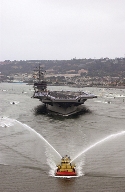Concern for the Environment
Long before protection of the environment became a prevalent endeavor, it was a high priority in the Naval Nuclear Propulsion Program. From the beginning, the Program recognized that the environmental safety of operating U.S. nuclear-powered ships would be key to their acceptance at home and abroad. The Program maintains the same rigorous attitude toward the control of radioactivity and protection of the environment as it does toward reactor design, testing, operation, and servicing. As a result, the Program has a well-documented record showing the absence of any adverse environmental effect from the operation of U.S. nuclear-powered warships. Because of this record, these ships are welcome in over 150 ports in over 50 countries and dependencies, as well as in U.S. ports.
 Environmental releases, both airborne and waterborne, are strictly controlled. As a result, the annual releases of long-lived gamma radioactivity from all Program activities are comparable to the annual releases from a typical U.S. commercial nuclear reactor operating in accordance with its NRC license. Throughout the Program’s entire history—over 5,900 reactor years of operation and more than 139 million miles steamed on nuclear power—there has never been a reactor accident, nor any release of radioactivity that has had an adverse effect on human health or the quality of the environment. The Program’s standards and record surpass those of any other national or international nuclear program. Environmental releases, both airborne and waterborne, are strictly controlled. As a result, the annual releases of long-lived gamma radioactivity from all Program activities are comparable to the annual releases from a typical U.S. commercial nuclear reactor operating in accordance with its NRC license. Throughout the Program’s entire history—over 5,900 reactor years of operation and more than 139 million miles steamed on nuclear power—there has never been a reactor accident, nor any release of radioactivity that has had an adverse effect on human health or the quality of the environment. The Program’s standards and record surpass those of any other national or international nuclear program.
The Program has a comprehensive environmental monitoring program at each of its major installations and facilities, including nuclear-capable shipyards and the homeports of nuclear-powered ships. This monitoring program consists of analyzing water, sediment, air, and marine samples for radioactivity to verify that Program operations have not had an adverse effect on the environment. Independent surveys conducted by the EPA and by state and local governments confirm that U.S. naval nuclear-powered ships and support facilities have had no discernible effect on the radioactivity of the environment.
Ensuring proper environmental performance has also been a priority at Program Department of Energy facilities, which are responsible for non-nuclear as well as nuclear environmental matters. Regular inspection of the Program’s laboratory and prototype sites by the EPA and state officials in accordance with the Clean Air Act, the Resource Conservation and Recovery Act (RCRA), and the Clean Water Act, has shown no significant problems.
The Program’s stewardship of the environment does not end when a facility ceases operations. For example, the Program has successfully released three former shipyards for unrestricted future use with respect to Program radioactivity: Ingalls Shipbuilding’s radiological facilities in Pascagoula, Mississippi (1982), and the Charleston and Mare Island Naval Shipyards in South Carolina and California (1996). These facilities’ unrestricted releases from Program radiological controls were independently verified and agreed with by the respective states and the Environmental Protection Agency (EPA). The successful inactivation and closure of these radiological facilities demonstrates that the stringent control exercised by the Program since its inception has been successful in protecting human health and the environment.
In October 2006, the U.S. Naval Nuclear Propulsion Program commemorated the first-ever unrestricted release of a U.S. nuclear power reactor site, based on the absence of both chemical and radiological constituents. After operating for 34 years and training over 14,000 sailors, the Department of Energy S1C Prototype Reactor Site in Windsor, Connecticut, was returned to “green field” conditions. Naval Nuclear Propulsion Program personnel and contractors worked in cooperation with the Connecticut Department of Environmental Protection, the EPA, the town of Windsor, and the public to complete this project. These agencies also provided independent oversight of the project. The current Windsor Site condition makes it suitable for any future use, without restriction, from economic development to recreation.
Finally, the Program maintains its environmental responsibilities from “cradle to grave”—from nuclear-powered warship design to ultimate disposal. The U.S. Navy’s program to safely dispose of decommissioned nuclear-powered submarines and cruisers is an example. It involves defueling the reactor(s), inactivating the ship, removing the reactor compartment for land disposal, recycling the remainder of the vessel to the maxi¬mum extent practical, and disposing of the remaining non-recyclable materials. The spent nuclear fuel removed from nuclear-powered warships constitutes about 0.05 percent of all spent nuclear fuel in the United States today. Also, it is ruggedly designed to withstand combat conditions, and can be safely stored pending ultimate placement in a geologic repository.
|
 |